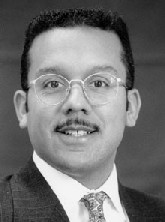America’s Racial Divide:
Of Debts Spoken and Unspoken

by Lucas E. Morel
August/September 2001
Over a decade ago, in an attempt to cut the Gordian knot of American racial animosity, Pulitzer-Prize-winning columnist Charles Krauthammer offered a modest proposal: “a monetary reparation to blacks for centuries of oppression in return for the total abolition of all programs of racial preference.” This year he resurrected his proposal, seeing no other alternative to the entrenchment of a racial spoils system that has only widened the racial divide among Americans. But would this really wipe the national slate clean of its nefarious color line?
Frederick Douglass once said that until justice is done for black Americans, race would continue to be a problem for America. Given that racial issues have made the news this year as much as ever before, one can conclude that justice in one way or another has still not been rendered to black Americans. Unfortunately, the problem derives in large part from a disagreement over the definition of justice. Unless a consensus forms around a common understanding of what America owes to all of her citizens, no solution to the problem of racial tension will arise.
Historically, America recognized a special debt to black citizens in the aftermath of the Civil War. By adding the 13th, 14th, and 15th Amendments to the U.S. Constitution, the nation attempted to operate more consistently with its founding principles and therewith provided greater freedom for blacks. But with the end of Reconstruction in 1877, and subsequent Supreme Court decisions that eroded federal protection of civil rights, black Americans found themselves with few friends among the whites who governed the United States. Almost one hundred years would pass before the federal government would put teeth into the constitutional bite of the Reconstruction Amendments.
The Civil Rights Act of 1964 became a landmark attempt by the federal government to protect the rights of all Americans from being infringed on account of race. Thankfully, the language of the Civil Rights Act, like that of the Declaration of Independence, was universal in scope. It called for the protection of “all persons” from racial discrimination, thereby teaching that the government of all should be partial to none in its enforcement of the laws.
Which is why “the debt” that is supposedly owed to black Americans today, for the harm done to blacks decades ago by whites, is one of dubious merit. It presumes that modern-day blacks cannot take advantage of today’s educational and employment opportunities because of the slavery and segregation of yesteryear. Curiously, the argument for reparations for black Americans reinforces the white supremacist claim of black inferiority.
The main reason Americans owe no monetary compensation to blacks is that it undermines our national commitment to the self-evident truth that “all men are created equal.” The “legacy of slavery” argument attributes black underachievement today to the effects of yesterday’s racial discrimination.
If this were true, why has the purported legacy of slavery and segregation not inhibited the ability of minorities to excel in music, entertainment, or sports? Why is affirmative action not needed in these arenas of human endeavor? Racial bigotry had long denied or limited the opportunities of minorities in these fields of human excellence. But as soon as discriminatory barriers of law and custom came down, minorities wasted little time in “catching up” in the race of life; they competed and in some cases now dominate in these chosen fields of human activity. Surely the enslavement or segregation of one’s ancestors holds little sway over one’s own ability or determination to succeed in 21st Century America.
Nevertheless, given an almost universal opinion among black Americans that white Americans “still don’t get it” when it comes to black grievances regarding America’s racist past, perhaps there’s more to this story. Ralph Ellison, author of Invisible Man, maintains that whites are indeed indebted to blacks for the unjust limitation upon their advancement that segregation, in particular, imposed for so many years. Ellison suggests that what accounts for the “black fury” even today stems from the inability of whites to acknowledge that their white ancestors were able to advance and succeed not merely because they did so “on merit,” but because they did not have to compete against blacks.
It’s not that Ellison wants his white neighbors to bend over so he can kick their behinds to get even. Rather, Ellison says it’s a matter of “moral perception, the perception of the wholeness of American life.” Because blacks in America have been viewed in relation to their color as opposed to their individual character and experience, many Americans tend to perceive them as living a separate existence from the mainstream of American life. This leads whites to think of their own achievements wholly apart from the reality of American society, where blacks were never far from the social, economic, or political action of the greater community. This moral blind spot to the presence of blacks, and hence to their contribution (willing and otherwise) to America’s prosperity, has served to divide whites from blacks to this day.
In this, Ellison differed from the late Justice Thurgood Marshall, whose dissenting opinion in Regents of the University of California v. Bakke (1978) defended racial quotas as payback for decades of favoritism toward whites during America’s slavery and segregation eras. He argued that it was long passed time for blacks to receive their due from the United States government—even if it meant denying the equal protection of the laws to white Americans. In short, America’s first black Supreme Court justice chose not to interpret the Constitution as a “color-blind” Constitution if a white American would be the first recipient of this freedom-loving interpretation of it.
No other justice joined Marshall’s opinion. And at this critical juncture in the Court’s adjudication on racial matters, Marshall missed an opportunity to help steer the high court toward a color-blind jurisprudence he himself favored when he was lead attorney for the National Association for the Advancement of Colored People. As a result, the nation was left with Justice Lewis Powell’s lone opinion that joined four justices in ruling that U.C. Davis Medical School violated the Civil Rights Act by reserving spaces for racial minorities, who were admitted with significantly lower test scores and grade point averages than Allan Bakke, a white applicant.
But Powell also joined four opposing justices who argued that the Constitution did not categorically prohibit a state medical school from adopting “race-conscious programs.” Powell spoke for a divided court in an opinion that received no other justice’s assent, but which nevertheless has stood as a de facto precedent because the Supreme Court has yet to revisit affirmative action in higher education. Contradictory opinions at the lower federal court level in recent years, especially this last year involving the University of Michigan and its law school, make the issue ripe for Supreme Court resolution.
Just a few years before the Bakke decision, Ellison penned an op-ed for the Los Angeles Times that recognized the economic progress of black Americans while arguing that progress in “middle-class values” was lacking. Entitled “When Does a Black Join the Middle Class? Not Just when He has a Good-Paying Job,” the editorial lamented the “ethnic provincialism” of many blacks who were earning better than they were spending—both in money and in leisure. Ellison argued that a “black-only” approach to culture narrowed the perspective of black Americans, and at a time when a majority could now afford to partake far and wide of the diverse opportunities in America for learning and enrichment.
He blamed militant leaders of the Black Power movement, like Stokely Carmichael and H. Rap Brown, for preaching the repudiation of middle-class values for the emotionally satisfying but intellectually vacuous reason of rejecting all things white. To reject American values as merely white values was to reject much of what made black Americans who they were as well as what made America what she was. These so-called reformers failed to acknowledge that the American experience included black as well as white contributions. Simply put, the black experience was a decidedly American experience, and therefore deserved closer examination as well as widespread celebration.
Ellison viewed black militants as unappreciative of what America had to offer by way of principles if not always by practice. Their turning away from America, in search of a more authentic identity in an “African heritage,” hurt those most in need of help—residents of the “urban ghettoes” of America’s great cities.
This reckless abandoning of all things American also confounded the majority of blacks who joined America’s middle class. Armed with the “financial ability and leisure time necessary to utilize libraries, bookstores, magazines, theaters, opera houses and other cultural and intellectual apparatus and institutions,” a majority of black Americans needed the encouragement of their putative leaders to take full advantage of what American slavery and segregation had denied them for so long. Instead, “by breaking the laws of man and God,” these self-proclaimed “saviors of the people” were leading the black middle class away from principles and institutions that held the best hope for their social, cultural, and political salvation.
As a black writer in 20th Century America, Ralph Ellison strove to master his craft as a novelist in order to mine the American folk tradition of Negro spirituals and blues for insight into America’s “identity crisis.” The search for, and evasion of, identity constitutes the American theme as individuals continue to test their practice against their professed ideals. Instead of reparations for blacks, Americans owe themselves a greater appreciation of the diverse efforts that produced America’s prosperity. E Pluribus Unum, “Out of Many, One,” therefore serves as a fitting national motto: it challenges American citizens of every race to understand the diverse history of their nation in light of the unifying ideals that made the American experiment of self-government possible. Its premise, that what unites Americans transcends their differences, points us in the right direction toward bridging America’s racial divide as citizens put into practice the only political principles that can bring unity out of diversity.
Lucas E. Morel is an Assistant Professor of Politics at Washington and Lee University and an Adjunct Fellow at the Ashbrook Center.
Copyright (c) 2001 The Ashbrook Center and The Multiracial Activist. All rights reserved.


Beautiful Site
7/12/2004 10:39:44 PM